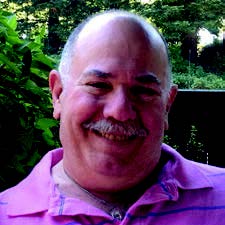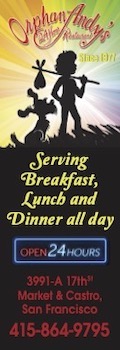Harry Hay: The Founder of Us All
 It was some time during the 1930s, Harry Hay remembered, when he turned to his then lover Will Geer to share an idea he had. Hay wanted to start a club or organization where men like “us” could meet to discuss issues important to them as homosexuals. “But honey,” Geer asked, “what would we talk about?” That was the question. Hay struggled to reply for more than a decade. When he did, he changed the world.
It was some time during the 1930s, Harry Hay remembered, when he turned to his then lover Will Geer to share an idea he had. Hay wanted to start a club or organization where men like “us” could meet to discuss issues important to them as homosexuals. “But honey,” Geer asked, “what would we talk about?” That was the question. Hay struggled to reply for more than a decade. When he did, he changed the world.
The answer came to him in 1948. Working for Henry Wallace’s third-party candidacy that year, Hay began to wonder about an “international…fraternal order” or “a service and welfare organization devoted to the protection and improvement of Society’s Androgynous Minority.” He dropped the term “androgynous” almost immediately, but his view that homosexuals were a “social minority” or “cultural minority” never changed. What that meant was exactly what gays would talk about.
Understanding that gays were a minority group, and the implications of that realization, changed everything that followed. At the time, gay men did not see themselves as a community. “The Queers,” Hay said later, “were the one group of disenfranchised people who did not even know they were a group because they had never formed as a group.” They had no acknowledged cultural traditions, no history, no political recognition, no legal protections. They knew that they were sexually attracted to other men— although some denied it—but there was little or no other sense of shared identity.
 Many men told Hay that an organization for them was impossible. Homosexual affection, even between consenting adults, was illegal in every state and territory. Gays who associated with each other risked harassment, and even arrest. Those convicted of homosexuality were forced to register as “sex offenders.” Repeat “offenders” could be sent to a state mental hospital for treatment, which often included electroshock therapy and castration; since the individuals were under a physician’s care, and not a court’s authority, a patient’s consent was not required and was seldom requested.
Many men told Hay that an organization for them was impossible. Homosexual affection, even between consenting adults, was illegal in every state and territory. Gays who associated with each other risked harassment, and even arrest. Those convicted of homosexuality were forced to register as “sex offenders.” Repeat “offenders” could be sent to a state mental hospital for treatment, which often included electroshock therapy and castration; since the individuals were under a physician’s care, and not a court’s authority, a patient’s consent was not required and was seldom requested.
Previous attempts to create gay organizations in the United States had been unsuccessful. As early as 1924, Henry Gerber suggested forming such a group for men who love men, “to combat the public prejudices against them,” but few were interested in joining him. “The average homosexual,” he remembered, “was ignorant concerning himself. Others were fearful. Still others were frantic or depraved. Some were blasé…They rejected our aims. We wondered how we could accomplish anything with such resistance from our own people.” His Society for Human Rights, which one newspaper described as a “Strange Sex Cult”—lasted less than a year.
It took Hay until 1950 to establish his organization. The first to join him was Rudi Gernreich, his lover at the time, who introduced Hay to gay men who not only were willing, but eager, to become involved. Even though, at the height of the federal government’s “homosexual witch hunt,” they were unsure that they could meet legally, the group, which included Chuck Rowland, Bob Hull, Dale Jennings, Konrad Stevens, and John Gruber, joined together for the first time on November 11, 1950, at Hay’s home in Los Angeles.
What Hay proposed to them was nothing less than a major paradigm shift in thinking about gays. Before the 20th century, homosexuality was believed to be a sin, an aberrant behavior, and not a sexual orientation or even an identification. That changed with the Freudians, who eventually argued it was a pathological abnormality or a mental disorder. In fact, Hay told the group, gay men were a distinct minority group, “a separate people,” not simply individuals who sought each other only for sex.
Everything flowed from Hay’s certainty. He and his friends had long discussions about what actually made them a minority group: their mutual sense of collective identity, the attributes that set them apart, their shared values and beliefs, their common history, the discrimination they all faced, and the ways in which they could help each other. These are simple sounding, obvious ideas today, but they were totally new then, when homosexuality was seen as a mental illness.
The group called itself the “Mattachine Society,” from the French “Société Mattachine,” well known for its medieval dancers who always wore masks when they appeared in public. “We took the name,” Hay explained, “because we felt that we 1950s Gays were also a masked people, unknown and anonymous, who might become engaged in morale building and helping ourselves and others, through struggle, to move toward total redress and change.”
Hay left the Mattachine Society in 1953, but remained an activist for the rest of his life. “We must,” he believed,” work collectively for the full first-class citizenship participation of minorities everywhere, including ourselves.” Because he understood that gays were a cultural minority, he opposed assimilation, which became a popular idea among gay rights advocates in the next decade. Some of his other opinions also became controversial, but his founding ideas, from which everything that followed emanated, are as vital today as when he first shared them:
A separate people,
We bring a gift to celebrate each other,
‘Tis a gift to be gay!
Feel the pride of it!
Bill Lipsky, Ph.D., author of “Gay and Lesbian San Francisco” (2006), is a member of the Rainbow Honor Walk board of directors.









Recent Comments